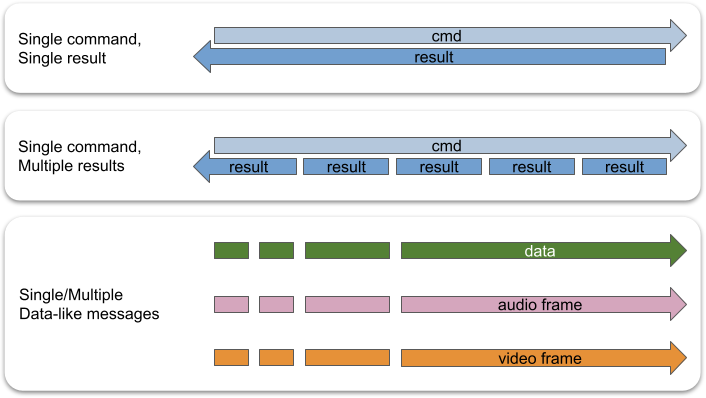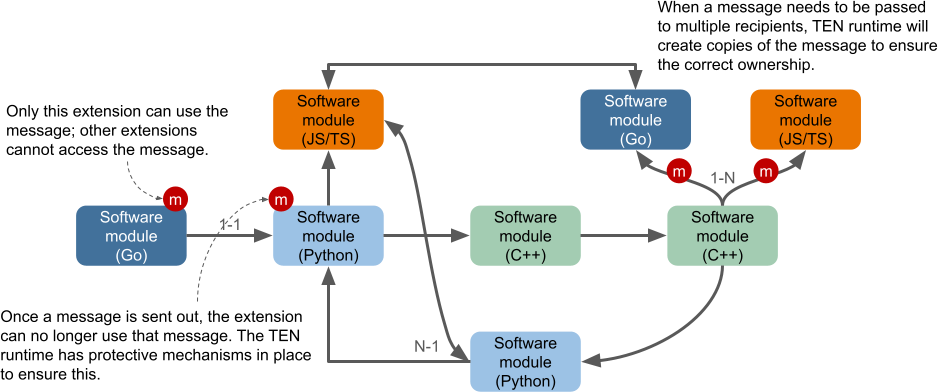Message system
Messages are the primary communication mechanism in the TEN framework, enabling extensions to exchange data, commands, and media content. The message system provides a structured, type-safe way for different components in your application to interact with each other.
The TEN message system offers several key benefits:
-
Type safety and validation: Each message type has defined schemas that ensure data integrity and prevent communication errors between extensions.
-
Asynchronous communication: Extensions can send and receive messages without blocking, enabling efficient parallel processing and responsive applications.
-
Clear interface definitions: Message APIs in manifest files provide explicit contracts between extensions, making it easier to understand how components interact.
-
Thread safety: The framework's ownership model ensures that messages can be safely passed between extensions running in different threads.
Messages in TEN work similarly to function calls in traditional programming, where message names act like function names, properties serve as parameters, and the framework handles routing and delivery between extensions.
Message types and categories
The TEN framework supports four message types, each serving different communication needs:
- Command: Request-response messages that expect a result. For example, configuration requests and status queries
- Data: One-way messages for streaming content, events, and application data
- Video Frame: Specialized messages for video content and metadata
- Audio Frame: Specialized messages for audio content and metadata
The following diagram shows this categorization:
The key distinction is that commands expect a response, while data, video, and audio messages are one-way communications.
Built-in vs custom messages
- Built-in messages start with
ten:and provide core framework functionality. - Custom messages use any other naming pattern and implement your application-specific logic.
Message handling callbacks
Extensions handle messages through specific callback methods:
OnCmdfor commandsOnDatafor data messagesOnVideoFramefor video framesOnAudioFramefor audio frames
Message naming and identification
The TEN framework uses message names to differentiate between messages of the same type but with different purposes. Extensions use these names to determine what actions to take when receiving messages.
Naming rules
Message names must follow these requirements:
- First character must be a letter (
a-z,A-Z) or underscore (_) - Subsequent characters can be letters (
a-z,A-Z), digits (0-9), or underscores (_) - Names starting with
ten:are reserved for framework built-in messages
Message pairing
The message pairing mechanism between extensions works like function calls in traditional programming:
- Message name acts as the function name - pairing relies solely on matching names
- Message properties serve as function parameters
- Routing occurs when an output message from one extension matches an input message name in another extension
The framework does not support message overloading - multiple messages with the same name but different properties are not allowed.
Message flow patterns
The TEN framework supports the following message flow patterns to handle different communication scenarios:
| Pattern | Description | Suitable for |
|---|---|---|
| One message, one result | A single command produces a single response | |
| One message, multiple results | A single command generates multiple responses over time | |
| Multiple messages | Multiple messages sent without expecting results |

API field types
The manifest API includes the following message direction specifications:
cmd_in: Commands the extension can receivecmd_out: Commands the extension can senddata_in: Data messages the extension can receivedata_out: Data messages the extension can sendvideo_frame_in: Video frames the extension can receivevideo_frame_out: Video frames the extension can sendaudio_frame_in: Audio frames the extension can receiveaudio_frame_out: Audio frames the extension can send
API definition structure
Each message definition includes the message name and property schema. Following is a sample API definition:
Message ownership and thread safety
The TEN framework uses an ownership model to ensure thread safety and prevent data races when messages are passed between extensions. Once a message is sent, the sending extension can no longer use it.
Ownership transfer to extensions
When the TEN framework delivers a message to an extension through OnCmd, OnData, OnVideoFrame, or OnAudioFrame callbacks, ownership transfers to the receiving extension. The framework guarantees that only the receiving extension has access to the message, ensuring safety across different threads.
The extension can freely use the message but must return ownership to the framework when finished. After returning ownership, the extension must not interact with the message.

Ownership transfer to the framework
When an extension sends a message using APIs like SendCmd, ReturnResult, SendData, SendVideoFrame, or SendAudioFrame, ownership transfers back to the TEN framework. The sending extension can no longer access the message after successful transmission.
Resource ownership
The ownership concept extends to all resources associated with a message, including buffers and data structures. Only one extension can own these resources at a time, mirroring the message ownership to maintain safety.
Copy semantics by default
To prevent data races from multiple extensions handling the same resource simultaneously, the TEN framework uses copy semantics by default when transmitting data across boundaries. Copying ensures ownership separation and maintains safety.
Borrowing semantics
The framework also supports borrowing semantics for enhanced resource utilization while maintaining safety. Extensions can temporarily use resources without taking ownership through borrowing APIs, but must use GiveBack APIs to return borrowed resources.
When returning message ownership to the runtime, all associated borrowed resources must also be returned. If an extension fails to return borrowed resources, the runtime rejects the message. For example, SendData will fail.
Commands and results
Commands are special messages that follow a request-response pattern, where the sending extension expects to receive a result back from the receiving extension.
Command structure
Commands can be sent by TEN clients and TEN extensions to other TEN extensions. You can also use commands in situations where the result isn't required - the TEN runtime automatically discards any unnecessary results.
Result format
A result is the response to a command. When extension A sends command X to extension B, extension B processes the command and sends a result back to extension A. Results can include meaningful details about the execution outcome.
The JSON representation of a typical result includes a status code: